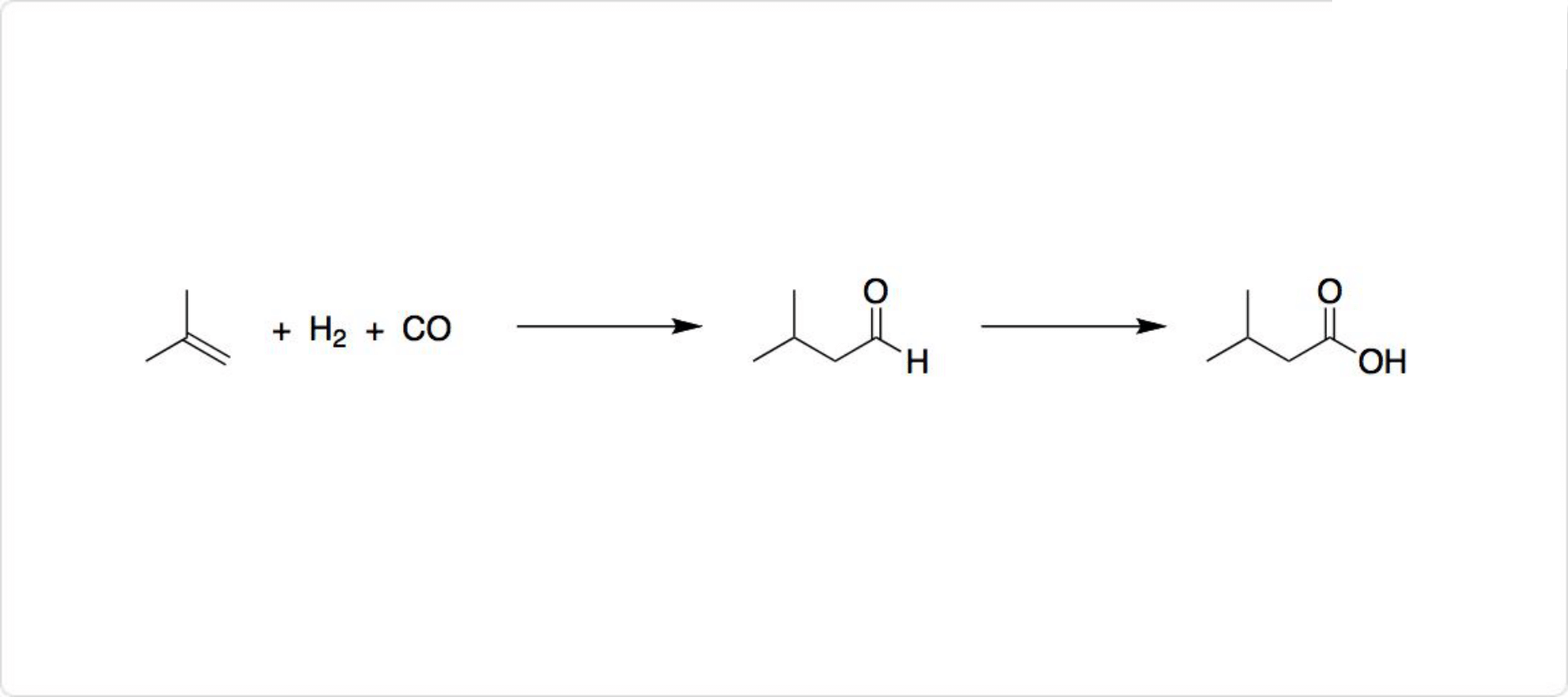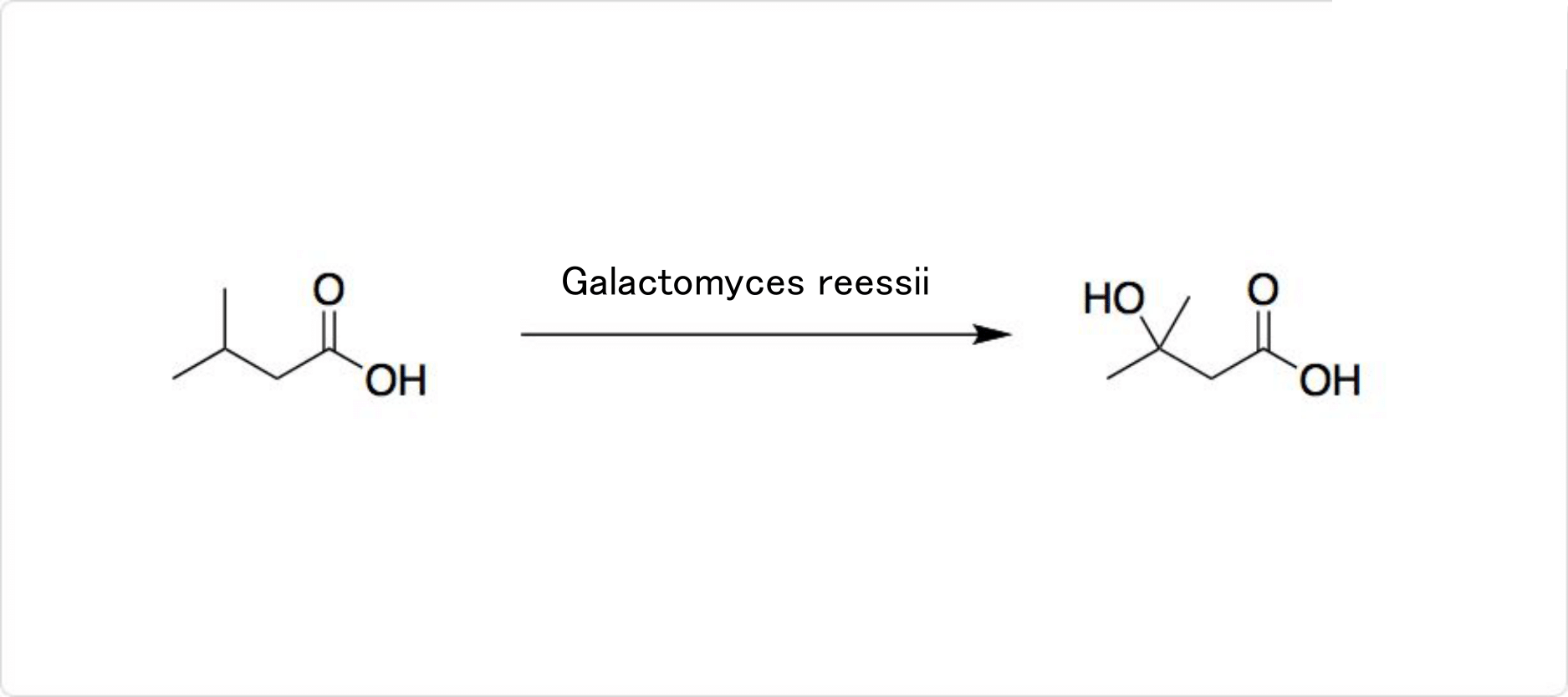-
外観
無色澄明の液体
-
性質
イソ吉草酸の融点は−29°Cで、沸点は175〜177°Cです。水には少し溶け、多くの有機溶媒にもよく溶解します。
イソ吉草酸には揮発性があります。酸味のある不快な腐敗したチーズのような臭気がある液体で、汗臭・足臭・加齢臭などの悪臭の原因物質です。
-
溶解性
水及びエタノールと任意の割合で混和する。
-
用途
大気中等イソ吉草酸のGC分析用標準液。
-
用途
イソ吉草酸自体にはチーズもしくは汗、足、加齢による口臭のにおいのような不快感を伴う刺激臭があるが、そのエステルは快い芳香を持つため香料として広く使われている。
-
用途
着香料原料、有機合成原料、医薬品原料(鎮静剤)。
-
構造
イソ吉草酸のモル質量は102.13g/molで、密度は0.925g/cm3です。示性式は(CH3)2CHCH2CO2Hと表されます。生物系の生理的pHで存在するのは、イソ吉草酸イオンである(CH3)2CHCH2COO-の形です。
イソ吉草酸は吉草酸の分岐構造を有する異性体です。構造異性体にはピバル酸やヒドロアンゲリカ酸も存在します。ピバル酸はピバリン酸トリメチル酢酸、ネオペンタン酸とも呼ばれます。
-
合成

図2. イソ吉草酸の合成
イソ吉草酸はセイヨウカノコソウ (英: Valerian) の微量成分であり、イソ吉草酸と名付けられました。セイヨウカノコソウの乾燥した根は、古代から薬用に使用されています。19世紀に初めて、アミルアルコールを含むフーゼル油 (英: Fusel alcohol) の成分の酸化によって、イソ吉草酸の研究が開始しました。
工業的には、イソブチレンのヒドロホルミル化によってイソバレルアルデヒドが形成され、酸化してイソ吉草酸が得られます。
-
解説
イソ吉草酸(isovaleric acid,3-methylbutanoic acid):(CH3)2CHCH2COOH.無色の酸味のある液体.融点-37 ℃,沸点175~177 ℃.d2040.935.n20D1.4043.24倍の水に可溶,エタノール,クロロホルム,エーテルに可溶.香料の原料.密栓して保存する.
-
説明
Isovaleric acid has a characteristic disagreeable odor. It is extremely
penetrating and persistent with a sour taste. May be synthesized by
oxidation of isoamyl alcohol or isovaleric aldehyde.
-
化学的特性
Isovaleric acid has a characteristic disagreeable, rancid, cheese-like odor. It is extremely penetrating and persistent with
a sour taste. May consist of one or a mixture of isomers or n-pentanoic acid and/or 2- or 3-methyl butanoic acid.
Consumption: Annual: 1850.00 lb
-
天然物の起源
Of the three possible isomers of n-valeric acid, only isovaleric acid has extensive application in flavoring;
originally reported in seal and dolphin fat; subsequently isolated from valerian. Also reported found in the essential oils of cypress,
citronella, laurel leaves, cajeput, Cymbopogon javanensis, hops, Persea pubescens, geranium, American peppermint, spearmint,
rosemary, lemongrass, Eucalyptus goniocalyx and other spp., tobacco, Monarda fistulos, Thymus mastichina, Artemisia frigida,
and probably in lavender; reported among the constituents of petitgrain lemon. Also reported found in many foods including apple,
currants, guava, grapes, papaya, peach, pineapple, raspberry, strawberry, potato, bell pepper, vinegar, breads, many cheeses, fish,
chicken, lamb, hop oil, beer, cognac, whiskies, cider, sherry, grape wines, rum, cocoa, tea, coffee, honey, soybean, passion fruit,
mushrooms, marjoram, plum, brandy, starfruit, trassi, rice, jackfruit, sake, sukiyaki, buckwheat, corn oil, cashew apple, malt, wort,
Bourbon vanilla, shrimp, mussels, cherimoya, Cape gooseberry and Chinese quince frui
-
使用
Isovaleric acid is used extensively as a flavoring ingredient in
nonalcoholic beverages and in foods such as ice cream,
candy, baked goods, and cheese, as a fragrance ingredient
in perfumes, and as a chemical intermediate in the
manufacture of sedatives and other pharmaceutical products.
It is also used as an extractant of mercaptans from petroleum
hydrocarbons, a vinyl stabilizer, and as an intermediate in the
manufacture of plasticizers and synthetic lubricants.
-
製造方法
By oxidation of isoamyl alcohol or isovaleric aldehyde
-
定義
ChEBI: A C5, branched-chain saturated fatty acid.
-
一般的な説明
Isovaleric acid is a colorless liquid with a penetrating odor. Isovaleric acid is slightly soluble in water. Isovaleric acid is corrosive to metals and to tissue.
-
空気と水の反応
Isovaleric acid is slightly soluble in water.
-
危険性
Strong irritant to tissue.
-
健康ハザード
TOXIC; inhalation, ingestion or skin contact with material may cause severe injury or death. Contact with molten substance may cause severe burns to skin and eyes. Avoid any skin contact. Effects of contact or inhalation may be delayed. Fire may produce irritating, corrosive and/or toxic gases. Runoff from fire control or dilution water may be corrosive and/or toxic and cause pollution.
-
火災危険
Non-combustible, substance itself does not burn but may decompose upon heating to produce corrosive and/or toxic fumes. Some are oxidizers and may ignite combustibles (wood, paper, oil, clothing, etc.). Contact with metals may evolve flammable hydrogen gas. Containers may explode when heated.
-
化学反応

図3. イソ吉草酸の反応
一般的にイソ吉草酸はカルボン酸として反応し、アミド、エステル、無水物、塩化物誘導体などを生成可能です。酸塩化物は合成中間体として広く使用されます。
真菌のガラクトミセス・レッシイ (英: Galactomyces reessii) によるイソ吉草酸の発酵で、3-ヒドロキシイソ吉草酸が合成されます。β‐ヒドロキシ‐β‐メチル酪酸は3-ヒドロキシイソ吉草酸の別名です。
-
構造異性体
吉草酸は直鎖状のカルボン酸で、示性式がCH3(CH2)3COOHで表される無色の液体です。密度は0.94g/cm3であり、融点は−34.5°Cで、沸点は186〜187°Cです。極性溶媒より無極性溶媒に溶ける最も低分子量のカルボン酸であり、pKaは4.82の弱酸で、人体に腐食性を示します。
ピバル酸はtert-ブチル基を有するカルボン酸です。密度は0.905g/cm3であり、融点は35.5°Cで、沸点は163.8°Cです。無色の液体または白色の結晶で、刺激臭を持っています。pKaは5.01で、水溶液は弱酸性を示します。
ヒドロアンゲリカ酸の示性式はC2H5(CH3)CHCOOHです。ヒドロアンゲリカ酸には鏡像異性体が存在します。密度は0.94g/cm3であり、融点は−90°Cで、沸点は176°Cです。
-
使用用途
イソ吉草酸は体臭等の悪臭成分ですが、イソ吉草酸エステルは快い芳香を持つため、非アルコール飲料やアイスクリーム、焼き菓子、チーズなどの食品の香料成分として使用されています。香水の香料成分としても利用可能です。
また、鎮静剤やその他の医薬品の製造でイソ吉草酸は、化学中間体として広く用いられます。
さらに、石油炭化水素からのメルカプタンの抽出剤、ビニル安定剤、可塑剤や合成潤滑油の製造の中間体としても使用されます。



